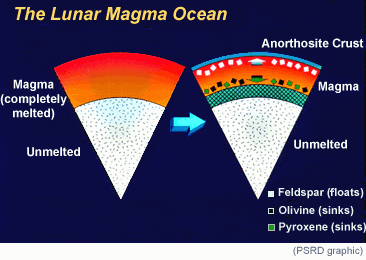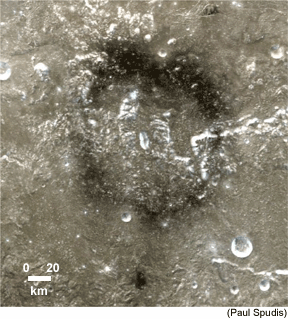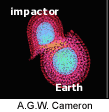|
|
|
|
|
|
|
![]() posted October 8, 2002
posted October 8, 2002
 |
The Moon Beyond 2002--- A meeting of lunar scientists to outline research questions and future exploration plans. |
| Written by G. Jeffrey Taylor
Hawai'i Institute of Geophysics and Planetology |
|
Over a hundred lunar scientists met in the clear mountain air of the Taos Ski Valley, September 12-14, 2002, to share their discoveries and, most importantly, their questions about the composition, geological evolution, and future exploration of the Moon. The wealth of data from the Clementine and Lunar Prospector missions, coupled with continued study of lunar samples, has led lunar scientists to pose sophisticated questions about the Moon. Because of the Moon's central role in planetary science, answers to these questions will help us understand the other rocky bodies in the Solar System. A fascinating array of missions is planned, including orbiting spacecraft and sample-return missions. Human habitation of the Moon may not be far beyond.
New Views of the Moon
Lunar science is vibrant. The cherished Apollo samples and other data from the Apollo program have been put into a whole new global context by the Clementine and Lunar Prospector missions. These new data have sparked new studies of lunar samples, and we have acquired numerous new lunar samples in the form of meteorites.
The New Views of the Moon initiative has been instrumental in promoting interdisciplinary studies using the new data. This initiative, led by Brad Jolliff (Washington University in St Louis) and the late Graham Ryder (Lunar and Planetary Institute), has organized several lunar science workshops, interdisciplinary sessions at the annual Lunar and Planetary Science Conference, and three special issues of the Journal of Geophysical Research. A comprehensive, interdisciplinary synthesis written by numerous lunar experts is in its final stages of editing.
 |
 |
A wide-ranging kick-off talk by Jim Head (Brown University) set the stage for the conference. Head focused on the central role the Moon plays in planetary science. He called the Moon the keystone to understanding planetary geological processes and history. Our knowledge of the formation and nature of impact craters, the nature of planetary differentiation and magmatic activity through time, and the tectonics on one-plate planets have been applied to understanding Mercury, Venus, Mars, and Io.
 |
CRATERS
All but a handful of lunar craters formed by meteorite impact. Studies of their sizes, shapes, depths, and composition of the material ejected have shed light on the cratering process and the use of craters as chronometers. |
 |
MAGMA OCEAN
The Moon preserves crucial clues to its initial separation into crust, mantle, and metallic core. The concept that the Moon melted substantially (possibly completely) when it formed, nicknamed the "magma ocean concept" is a fundamental tenet of lunar science, and many planetary scientists suspect that the other rocky planets also melted substantially during or soon after their formation. |
 |
VOLCANISM
The dark ring in this Clementine mosaic of the southwestern Orientale basin on the Moon is a glassy volcanic deposit, perhaps similar to deposits on Mercury and Io. |
 |
TECTONICS
Wrinkle ridges, like the one shown here, demonstrate one way in which the lunar surface was deformed by tectonic forces. The Moon is a model of deformation on one-plate planets. |
Dark, Icy Poles
If anything needs a closer look it is the concept that there are vast quantities of water ice in permanently shadowed areas in the lunar polar regions. This idea was first proposed several decades ago. Theoretical considerations led to the idea that water could be trapped in permanently shadowed regions near the lunar poles. The Clementine [see PSRD article: Ice on the Bone Dry Moon] and Lunar Prospector missions and radar measurements with the Arecibo radio telescope appear to have confirmed the predictions, though there are still some skeptics. Measurements by the Prospector neutron spectrometer show that concentrations of H are coincident with permanently shadowed craters. However, the case is not closed. For example, we do not know if the H is in water ice or some other form, or the total concentration. We also do not know whether the hydrogen comes from the solar wind or from the impact of millions of comets. Richard Vondrak (Goddard Space Flight Center) reported on a model he has been developing with Dana Crider (Catholic University of America). They conclude that all the observed hydrogen at the poles could be derived from implanted hydrogen that has been mobilized by micrometeorite impacts and sputtering by cosmic rays. There is no need to call upon H2O delivery by comets. This is surprising because comets are loaded with water ice and organic compounds (hence hydrogen) and have been smashing into the Moon for billions of years. Crider and Vondrak suggest a comet impact might produce such a hot, gaseous plume that almost all the water escapes
Whatever the source of the hydrogen, it is clear that we need more data. Specifically, we need to make more thorough maps of the distribution of permanently shadowed regions, search for ice and H concentrations with high-resolution synthetic aperture radar and neutron spectrometry, and landed missions to determine the volatile species present. This is an interesting scientific problem. Perhaps even more important, large deposits of ice at the poles could drive settlement of the Moon by humans. We need to make a complete inventory of the amount of hydrogen, water ice, and other volatiles in the lunar polar regions.
 |
Complete characterization of lunar polar deposits requires additional missions to the Moon, such as the Polar Night mission depicted here. Paul Lucey (University of Hawaii) described the concept of Polar Night, which integrates in situ and orbital measurements. |
The Complicated Lunar Surface
The more we learn the more complicated the lunar surface becomes. Tom Prettyman, David Vaniman, and their colleagues at Los Alamos National Laboratory have used special data processing techniques to determine the concentrations of major elements from Lunar Prospector gamma-ray data. They show that the most abundant compositions on the surface are matched by some of the rarer rocks in our collections. For example, lunar meteorites seem to be more characteristic of the lunar highlands than samples of the surface dirt collected by Apollo. Even more curious, rocks with high ratios of magnesium to iron and low concentrations of thorium may be quite abundant in some regions of the Moon, especially in the north polar regions. Not everyone is convinced that the magnesium determination is calibrated sufficiently, but these preliminary results are interesting and, if they survive careful scrutiny, may have important implications for the origin of the lunar crust. Characterization of the rocks in these areas will have to wait for future missions to test the magnesium concentration by independent techniques (for example, orbital x-ray spectrometry and sample return missions), but it shows that the Moon's crust is compositionally diverse.
 |
 |
| Tom Prettyman and his colleagues calculated the concentration of aluminum, magnesium, and iron in all pixels in a Prospector global data set (with each pixel corresponding to an area 5 degrees on a side). They divided the data on this diagram of Al vs. the ratio Mg/(Mg+Fe) into separate regions, producing a map of the variations. The data with the highest Mg/(Mg+Fe) ratio (light blue) plot in continuous areas of the lunar highland, most notably in the north polar region. These areas are also low in thorium and might represent intrusions of magnesian magma into the ancient lunar crust. |
Jeffrey Gillis (Washington University in St. Louis) used Clementine and Prospector to investigate the nature of the lunar maria. He reported that there are basaltic rocks in Mare Australe that are distinctly different from other maria. They are lower in iron and contain significant amounts of low-calcium pyroxene. This implies that they formed by melting of compositionally and mineralogically distinctive regions in the lunar mantle. Harry Hiesinger (Brown University) and his colleagues have also been making detailed studies of the lunar maria, including determining their ages by counting craters. They find no correlation between age and composition. In fact, high-titanium and low-titanium lava flows can occur almost simultaneously. Age is, however, correlated with location: the flows in the western maria are youngest. Paul Spudis (Lunar and Planetary Institute and now at the Applied Physics Laboratory at Johns Hopkins University) told PSRD that the eastern maria, such as Mare Smythii, are also relatively young. Hiesinger has not yet studied those maria. Lava flows are not confined to the maria. B. Ray Hawke (University of Hawaii) and his colleagues reported definitive evidence for volcanism in regions away from the lunar maria. The compositions of these lavas are clearly different from those of mare basalts.
In the mid-1970s, Henry Moore, Desiree Stuart-Alexander, and their colleagues at the U. S. Geological Survey described unusual grooves that scour the rims of old craters at the antipode of the huge Imbrium basin. They suggested that the grooves formed by the convergence of debris from the Imbrium basin. Larry Haskin (Washington University in St. Louis) took up this idea and proposed a few years ago that the formation of the large Imbrium basin on the lunar nearside caused the deposition of a significant amount of material antipodal to it. This, Haskin has argued, accounts for an increase in the thorium content of northwest portion of the South Pole-Aitken basin, located in the southern part of the lunar farside. Thorium is enhanced because it occurs in relatively high concentration in and around the Imbrium region. This was generally greeted with enthusiastic skepticism. However, one of the skeptics, Paul Spudis, decided to test the idea. He looked at the compositions of ejecta near the rims of two basins (Orientale and Imbrium) and compared them to the compositions of surfaces at the antipodes of these basins. If the antipodal deposition idea is correct, the near-basin deposits ought to be very similar to those at the basin antipodes. The results show that the range of compositions at the antipodes is more restricted than the range observed for the near-rim deposits. Nevertheless, the antipode compositions form a subset of the near-basin ejecta, suggesting that a significant amount of antipodal material could be primary ejecta from the basin-forming event. Thus, the data are consistent with (but do not prove) the antipodal-deposition hypothesis. Spudis plans to study additional basins.
 |
| Compositional data for basin ejecta and material at the antipode to each basin. The corners of the triangles represent titanium (Ti), a measure of the abundance of the mineral ilmenite; iron minus titanium (Fe-Ti), a measure of iron in silicate minerals; and aluminum (Al), which tracks feldspar abundance. Material at the antipode of two large lunar basins (Imbrium and Orientale) is similar to that near the rims of the basins, suggesting that a large impact may concentrate ejecta antipodal to the site of impact. |
Marc Norman (Australian National University) and colleagues at the Johnson Space Center and the University of New Mexico have been hammering away at determining the formation ages of anorthosites from the Apollo 16 landing site. This site is the only one that resembles the large anorthositic (feldspar-rich) regions of the lunar highlands, so detailed study of the anorthositic rocks from the site can shed light on the formation of the oldest lunar crust. Anorthosites are thought to have formed when plagioclase feldspar floated in a global ocean of magma that developed soon after the Moon formed. This means that they ought to be very old, somewhere around 4.4 to 4.5 billion years, but the four dated so far have samarium-neodymium (Sm-Nd) ages of 4.29 to 4.54. Why the large range? Norman noted that the plagioclase in the rocks has been compositionally modified by exchange after crystallization, most likely by a large impact event around 3.9 billion years ago, but that pyroxene is more likely to have remained unchanged. When he plots the pyroxene isotopic data for Sm and Nd the points from all four rocks fall on a very precise line (called an isochron) defining an age of 4.456 billion years (plus or minus 0.040 billion years). He suggested that this is a robust estimate for the crystallization age of lunar anorthosites. (The formation of anorthosites and the significance of their ages will be the subject of a future PSRD article based on Marc Norman's work.)
 |
| Isotope plot for Nd and Sm isotopes in lunar anorthosites. The blue circles are for pyroxene crystals in four lunar anorthosites. The red circles are for plagioclase feldspar. The pyroxene data define a very precise line, the slope of which defines the age, 4.456 billion years. Plagioclase data scatter more because of chemical exchange of Sm and Nd caused by reheating by a large impact event that seems to have affected almost all anorthosites. Pyroxene is more resistent to isotopic exchange so records the original crystallization age. |
Chemical Composition of the Moon
Determining the composition of the planets is very important for testing models for how they formed. For example, recent numerical simulations of planet formation by J. E. Chambers (NASA Ames Research Center) indicate that the terrestrial planets were constructed mostly from planetesimals that came from relatively narrow regions, though there is considerable mixing throughout the inner solar system. This suggests that the Earth and Moon were made from compositionally similar materials. Thus, if the Moon formed as the result of a giant impact between a large planetesimal (called a planetary embryo) and the growing Earth, the simulations suggest that the impacting embryo was similar in chemical composition to the Earth. Chemical and physical processes that operated after the giant impact would have been the cause of any differences in composition between the Earth and Moon. Knowing the composition of the Earth and Moon would allow us to quantify the effects of a giant impact.
 |
Computer simulation of the formation of the Moon by a giant impact, courtesy of A. G. W. Cameron (Harvard-Smithsonian Center for Astrophysics). Blue areas are metallic iron, and red and orange areas are rocky mantles. The metallic core of the impactor accretes to Earth's core, allowing the Moon to form from material depleted in metallic iron. Knowing the chemical composition of the Earth and Moon will allow scientists to better understand the chemical processes that might have operated during such an event. |
The composition of the Moon is not known with sufficient certainty to allow us to probe the effects of the Moon-forming giant impact. Brad Jolliff (Washington University in St. Louis) and I gave talks in which we tried to place limits on the lunar bulk silicate composition. Both of us use the vastly improved knowledge of the composition of the crust, but there are uncertainties in the thickness of the crust and the volume of distinct compositional zones. Most important, our knowledge of the composition of the lunar mantle, the zone of denser rock beneath the crust, is very uncertain. In particular, we do not know the concentrations of iron, magnesium, and aluminum oxides. In spite of the uncertainties, most of us believe that the Moon is enriched compared to Earth in refractory elements such as thorium and aluminum, and probably somewhat enriched in iron oxide. However, the uncertainties in the estimates allow for the Earth and Moon to be nearly identical in composition. More data are clearly needed. In particular, we need better measurements of the thickness of the crust and the mineralogy of the mantle, which can be made by a global network of seismometers.
Aiming for the Moon
When the Apollo program ended in 1972, the Moon appeared to have been declared a no-fly zone. That ended with the Clementine mission in 1994, followed by Lunar Prospector in 1997. Several new missions are now planned. These missions will obtain data that are much needed, according to discussions during the Taos meeting. They will deploy seismometers to determine the size of the lunar core, analyze the surface composition for elements not determined precisely, study volatile substances and the geology of the polar regions, and return samples from the largest lunar basin. The missions are being planned by the Japanese space agency and the European Space Agency. The U. S. National Research Council has recommended that a sample-return mission to the South Pole-Aitken basin be given a high priority in NASA's mission planning. If all goes as planned, we will know vastly more about the Moon a decade or less from now. For a concise overview of mission plans, see Leonard David's article in Space.com, Mission Planners Shoot for the Moon.
The NASA Exploration Team (NExT) is developing exciting plans for a human return to the Moon. Some of the plans were highlighted at the Taos meeting. A centerpiece of the planning is the use of the Earth-Moon Lagrangian point, L1. From this gravitationally balanced place in space astronauts will have easy access to anywhere in the Earth-Moon system, opening up endless possibilities. NExT plans are described in another article by Leonard David in Space.com, NASA Reveals New Plan for the Moon, Mars & Outward.
|
|
[ About PSRD |
Archive |
Search |
Subscribe ] [ Glossary | General Resources | Comments | Top of page ] |